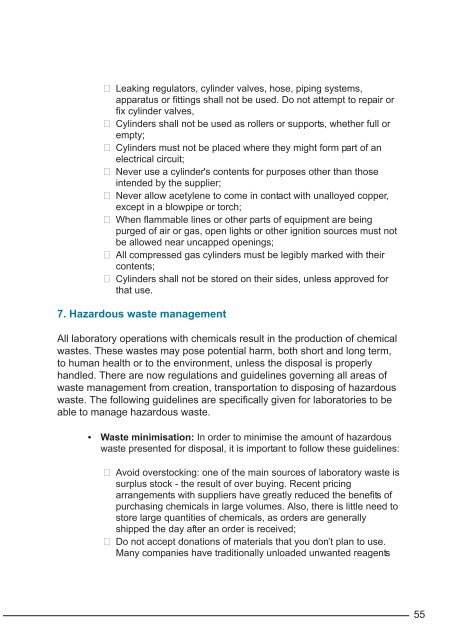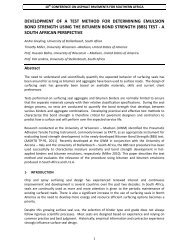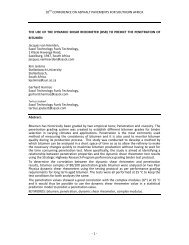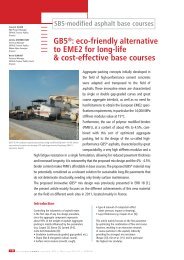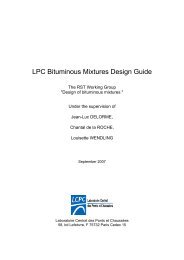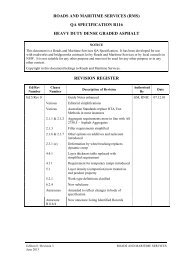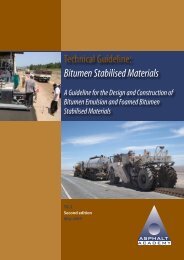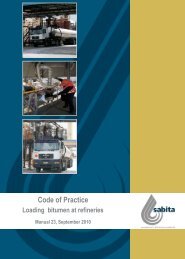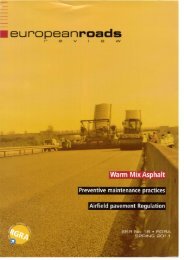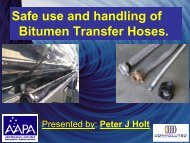Guide to the safe handling of solvents in a bituminous ... - Aapaq.org
Guide to the safe handling of solvents in a bituminous ... - Aapaq.org
Guide to the safe handling of solvents in a bituminous ... - Aapaq.org
- No tags were found...
You also want an ePaper? Increase the reach of your titles
YUMPU automatically turns print PDFs into web optimized ePapers that Google loves.
Leak<strong>in</strong>g regula<strong>to</strong>rs, cyl<strong>in</strong>der valves, hose, pip<strong>in</strong>g systems,apparatus or fitt<strong>in</strong>gs shall not be used. Do not attempt <strong>to</strong> repair orfix cyl<strong>in</strong>der valves, Cyl<strong>in</strong>ders shall not be used as rollers or supports, whe<strong>the</strong>r full orempty; Cyl<strong>in</strong>ders must not be placed where <strong>the</strong>y might form part <strong>of</strong> anelectrical circuit; Never use a cyl<strong>in</strong>der's contents for purposes o<strong>the</strong>r than those<strong>in</strong>tended by <strong>the</strong> supplier; Never allow acetylene <strong>to</strong> come <strong>in</strong> contact with unalloyed copper,except <strong>in</strong> a blowpipe or <strong>to</strong>rch; When flammable l<strong>in</strong>es or o<strong>the</strong>r parts <strong>of</strong> equipment are be<strong>in</strong>gpurged <strong>of</strong> air or gas, open lights or o<strong>the</strong>r ignition sources must notbe allowed near uncapped open<strong>in</strong>gs; All compressed gas cyl<strong>in</strong>ders must be legibly marked with <strong>the</strong>ircontents; Cyl<strong>in</strong>ders shall not be s<strong>to</strong>red on <strong>the</strong>ir sides, unless approved forthat use.7. Hazardous waste managementAll labora<strong>to</strong>ry operations with chemicals result <strong>in</strong> <strong>the</strong> production <strong>of</strong> chemicalwastes. These wastes may pose potential harm, both short and long term,<strong>to</strong> human health or <strong>to</strong> <strong>the</strong> environment, unless <strong>the</strong> disposal is properlyhandled. There are now regulations and guidel<strong>in</strong>es govern<strong>in</strong>g all areas <strong>of</strong>waste management from creation, transportation <strong>to</strong> dispos<strong>in</strong>g <strong>of</strong> hazardouswaste. The follow<strong>in</strong>g guidel<strong>in</strong>es are specifically given for labora<strong>to</strong>ries <strong>to</strong> beable <strong>to</strong> manage hazardous waste.• Waste m<strong>in</strong>imisation: In order <strong>to</strong> m<strong>in</strong>imise <strong>the</strong> amount <strong>of</strong> hazardouswaste presented for disposal, it is important <strong>to</strong> follow <strong>the</strong>se guidel<strong>in</strong>es: Avoid overs<strong>to</strong>ck<strong>in</strong>g: one <strong>of</strong> <strong>the</strong> ma<strong>in</strong> sources <strong>of</strong> labora<strong>to</strong>ry waste issurplus s<strong>to</strong>ck - <strong>the</strong> result <strong>of</strong> over buy<strong>in</strong>g. Recent pric<strong>in</strong>garrangements with suppliers have greatly reduced <strong>the</strong> benefits <strong>of</strong>purchas<strong>in</strong>g chemicals <strong>in</strong> large volumes. Also, <strong>the</strong>re is little need <strong>to</strong>s<strong>to</strong>re large quantities <strong>of</strong> chemicals, as orders are generallyshipped <strong>the</strong> day after an order is received; Do not accept donations <strong>of</strong> materials that you don’t plan <strong>to</strong> use.Many companies have traditionally unloaded unwanted reagents55


